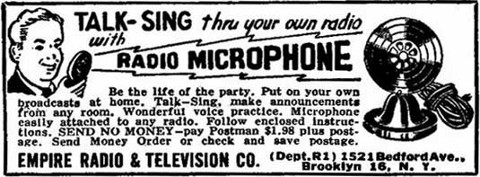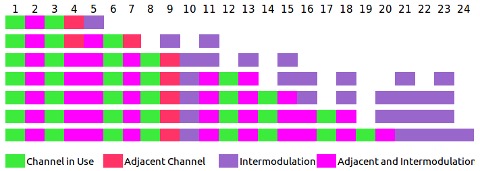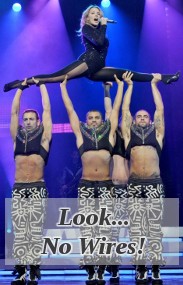Thursday 4 April, 2013, 22:05 - Licensed, Spectrum Management, Chart Predictions
Posted by Administrator
Posted by Administrator
 It is now only a month or so before the annual pan-European musical bun fight that is the Eurovision Song Contest (which is on the 18th of May). The 39 songs that have made it to the competition (which this year is in Malmo, Sweden) are now available to listen to online - with many having professionally produced videos viewable on YouTube. As always there is a mix of complete Euro-nonsense (Greece with their song Alcohol Is Free), songs that could have been written for Eurovision any time from 1960 to the present day (Switzerland's song You And Me falls into this category) copies of last year's winner in the hope that people will want the same thing again this year (Germany's Glorious for example), sickly pop songs with no real substance (Finland's Abbaesque entry Marry Me) and this year, it seems, a whole swathe of rather nice ballads.
It is now only a month or so before the annual pan-European musical bun fight that is the Eurovision Song Contest (which is on the 18th of May). The 39 songs that have made it to the competition (which this year is in Malmo, Sweden) are now available to listen to online - with many having professionally produced videos viewable on YouTube. As always there is a mix of complete Euro-nonsense (Greece with their song Alcohol Is Free), songs that could have been written for Eurovision any time from 1960 to the present day (Switzerland's song You And Me falls into this category) copies of last year's winner in the hope that people will want the same thing again this year (Germany's Glorious for example), sickly pop songs with no real substance (Finland's Abbaesque entry Marry Me) and this year, it seems, a whole swathe of rather nice ballads. For what it's worth, Wireless Waffle is particularly fond of the Icelandic entry (Ég á Líf), the video for which awaits your enjoyment below. If you are of an emotionally sensitive disposition, make sure you have some tissues to hand.
Our selection of songs that ought to be in the top 5, at least if they are able to reproduce the performance in their videos on stage on the night are:
- Eyþór Ingi Gunnlaugsson - Ég á Líf (Iceland)
- Roberto Bellarosa - Love Kills (Belgium)
- Zlata Ognevich - Gravity (Ukraine)
- Despina Olympiou - An Me Thimáse (Cyprus)
- Dina Garipova - What If (Russia)
What has become more complex, though, is the use of wireless technology for the event. Whilst it's still normal in a concert hall to use wired cameras, the use of radiomicrophones and in-ear monitors (which allow the performer to hear themselves sing without the noise of the surrounding environment) has grown significantly over recent years. Figures provided in response to a European Commission consultation on programme making spectrum show an average annual growth of 12% in the number of such devices employed over the past 15 years (but nearly 40% growth per year over the last 4 years).
| Year | Venue | Radiomicrophones used | In-Ear Monitors used |
|---|---|---|---|
| 1998 | Birmingham, UK | 40 | 2 |
| 1999 | Jerusalem, Israel | 42 | 6 |
| 2000 | Stockholm, Sweden | 48 | 16 |
| 2001 | Copenhagen, Denmark | 48 | 16 |
| 2002 | Tallinn, Estonia | 54 | 16 |
| 2003 | Riga, Latvia | 54 | 16 |
| 2004 | Istanbul, Turkey | 54 | 16 |
| 2005 | Kiev, Ukraine | 54 | 16 |
| 2006 | Athens, Greece | 54 | 16 |
| 2007 | Helsinki, Finland | 56 | 16 |
| 2008 | Belgrade, Serbia | 56 | 16 |
| 2009 | Moscow, Russia | 56 | 16 |
| 2010 | Oslo, Norway | 72 | 32 |
| 2011 | Düsseldorf, Germany | 82 | 40 |
| 2012 | Baku, Azerbaijan | 104 | 80 |
What is driving this growth? One the one hand, the equipment costs are coming down making it more affordable to use wireless microphones. On the other, it's also probably true that in earlier years, microphones would be passed from one user to another as they went on/off stage whereas now each artist and band has their own set of equipment which is tailored to their own needs.

Equipment is one thing, but what about the radio spectrum issues? Radiomicrophones and in-ear monitors are normally analogue (for reasons that can wait for another day) and use around 200 kHz of spectrum each. If all the devices in Baku (184) were turned on at the same time, they would need 37 MHz of spectrum just to exist. But this is not the full story. Firstly, if devices were 200 kHz apart, there would be not a sliver of a gap between them. Whilst they could all successfully transmit, even the smartest digital receivers would find it difficult to separate them from each other - and we aren't dealing with digital technology. In reality, frequencies are separated by at least 300 kHz and often more to allow the receivers room to breathe.
The situation is even worse than this however. Due to the close proximity of devices to each other, and of devices to receivers, there is a tendency for lots of intermodulation to occur. If you assume that each 200 kHz channel that can be used is numbered, starting at 1 then you can't use the adjacent channel because it's too close. You also, because of intermodulation, can't use any channel which represents the difference or sum of twice the value of one channel being used minus another channel being used. As and example:
- If you are using channels 1 and 3 (channel 2 is adjacent to channel 1, so you can't use that), you can't use channel 4 (as its adjacent to 3) or channel 5 (as its 2*3-1). The next available channel is 6.
- If you are using channels 1, 3 and 6, you now also can't use channel 7 (adj to 6). The next available channel is 8.
- If you are using channels 1, 3, 6 and 8 you now can't use channels 9 (adj to 8), 10 (2*8-6) or 11 (2*6-1). The next available channel is 12.
The diagram below shows the situation. Green channels are those in use. Red channels are adjacent channels that can't be used. Purple channels are intermodulation products. Pink channels are both at the same time!

In the example given above, out of 24 available channels, only 8 are useable. Actually, if you extended the diagram at this point you would find that another 10 channels are already 'wallied out' because of intermodulation. So 8 transmitters has used 34 frequencies! The relationship between the number of transmitters on-air and the number of channels sterilised is not linear but in general something of the order of 1 frequency in 5 can be used for radiomicrophones where they are packed densely in a given location if these problems are to be avoided.
This represents pretty poor frequency efficiency but is fairly representative of what is achieved in real life, which is that only something like one fifth of any spectrum available for radiomicrophones or in-ear monitors can be used in any one venue at the same time. Returning to Baku then, the amount of spectrum required is not 37 MHz, but to support 184 devices simultaneously would require more like 184 MHz of spectrum: give or take 1 MHz per device!
Most radiomicrophones (and in-ear monitors) operate in and amongst television broadcasts in the UHF band which notionally runs from 470 to 862 MHz. In many countries, however, the upper end of this band from 790 MHz upwards has now been set-aside for mobile broadband services, leaving 320 MHz remaining for television broadcasting (and of course radio microphones).
 Azerbaijan, last year's host of the Eurovision, is yet to switch over to digital TV and equally has not yet used the upper part of the UHF TV band for mobile services and so finding 180 MHz of spectrum for radiomicrophones is presumably not that difficult. In 2013, however, the contest is in Malmo, Sweden. Not only has Sweden cleared the upper part of the UHF band for mobile services, but it has also gone over to digital broadcasting. Malmo is virtually on the border between Sweden and Denmark meaning that the local TV spectrum will be occupied not only by the 8 Swedish multiplexes but by the Danish ones too. Finding 180 MHz of spectrum for this year's competition is therefore much more challenging.
Azerbaijan, last year's host of the Eurovision, is yet to switch over to digital TV and equally has not yet used the upper part of the UHF TV band for mobile services and so finding 180 MHz of spectrum for radiomicrophones is presumably not that difficult. In 2013, however, the contest is in Malmo, Sweden. Not only has Sweden cleared the upper part of the UHF band for mobile services, but it has also gone over to digital broadcasting. Malmo is virtually on the border between Sweden and Denmark meaning that the local TV spectrum will be occupied not only by the 8 Swedish multiplexes but by the Danish ones too. Finding 180 MHz of spectrum for this year's competition is therefore much more challenging.But move forward 10 years and then what will happen. For starters, at the current rate of growth, and assuming no improvement in the spectrum efficiency of wireless microphone technology, there will be a requirement for 560 MHz of spectrum for the Eurovision. Secondly, the parts of the UHF TV band currently unoccupied and used for these purposes will be full of 'cognitive radio' devices hunting out every last vestige of unused spectrum. What will happen then? The simple fact is that no-one really knows, but the programme making community are worried, and understandably so. If there was a way around the intermodulation problem, then the amount of spectrum required would decrease, so perhaps now is the time for some enterprising RF engineer to find a solution to this problem so that we can continue to enjoy the pageantry of the world's greatest song contest. Either that or sing less? Some would argue that for the Eurovision that would be no bad thing.
add comment
( 1871 views )
| permalink
| 



 ( 3.1 / 7494 )
( 3.1 / 7494 )




 ( 3.1 / 7494 )
( 3.1 / 7494 )
Wednesday 13 March, 2013, 08:00 - Chart Predictions
Posted by Administrator
To be truthful, most of the so-called 'chart preductions' that have previously bedecked the pages of Wireless Waffle, have been little more than excuses to showcase some great music heard whilst travelling, none of which is really that likely to chart in the UK, and most of which has already been a hit in the home country of the artist concerned. So chart, yes. Predictions, um, less so.Posted by Administrator
This time is different though! The single for Deine Stärken by German band Silly is not due to be released until tomorrow (March 14) so this really is a chart prediction (though the download has been available since 1 March). As with other Wireless Waffle song selections, the probability of it reaching the top of the UK charts is rather slim, not least because there have only ever been 3 German language songs that have even made it into the top:
- Nicole - Ein bißchen Frieden (1982)
- Nena - 99 Luftballons (1984)
- Falco - Rock Me Amadeus (1985)
But in German speaking countries such as, Germany, Austria, Switzerland and Belgium (yes, German is an official language of Belgium too) as well as in many other countries where the language of a song is not such a barrier to success as it is in English speaking countries, Wireless Waffle strongly tips Deine Stärken (Your Strengths) for great things.
Silly have been around for a long time, having originally formed in 1978 in the now defunkt East Germany. In 1996 the band's original lead singer Tamara Danz sadly lost her life to breast cancer. From 2005 the band re-formed and went on the hunt for a new lead singer, eventually settling on the current chanteuse Anna Loos (also an actor). What a great choice, as this single attests. You don't need to understand German to hear the depth of emotion that comes through in this anthemnic rock ballad.
So it's 5 stars from Wireless Waffle and here's hoping the first chart prediction that will prove successful. If it does, we'll be sure to let you know!
Friday 8 March, 2013, 16:04 - Chart Predictions
Posted by Administrator
Wireless Waffle had the good fortune to have visited Africa this week. One thing that's always a pleasure when visiting other countries, let alone other continents, is the chance to listen to local radio stations and hear new music.Posted by Administrator
It was therefore a joy to come across this piece of music from Nigerian singer Omawumi. 'Stay Alive (Je Je Laye)' is mellow, uplifting and unquestionably African. A glorious tune and well worth a listen.
Toto's 1982 song 'Africa' was also heard on the radio. The mind can but boggle at how much Toto must make in royalties every day, from radio stations right across the continent. Do British rockers Asia do as well from their eponymous brethren? The answer to that can no doubt be found on the airwaves too...
Wednesday 4 July, 2012, 21:40 - Chart Predictions
Posted by Administrator
Another random pop prediction from the Wireless Waffle team. This time it's Southampton's very own Gareth Emery who has teamed up with the daughter of television chef Jean-Christophe Novelli to cook up a delightful tune called 'Concrete Angels'.Posted by Administrator
It seems unlikely that this will ever truly make the charts (not least it was released 5 months ago and is yet to challenge the chart countdown). But here at WW we thought that the clever use of the lights in tower blocks to represent electronic volume meters was pretty suave. Definitely a late night tune, headphones on, lights out, eyes closed. Or is that just us?


